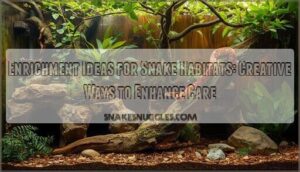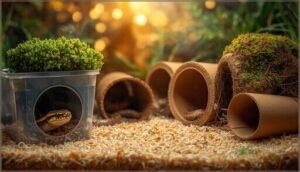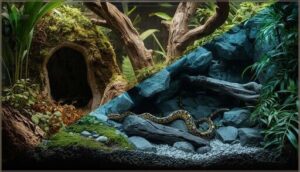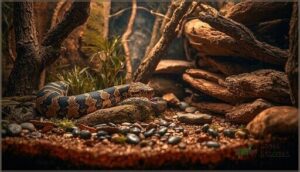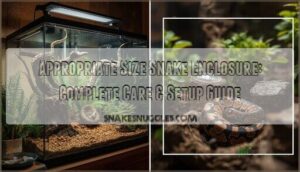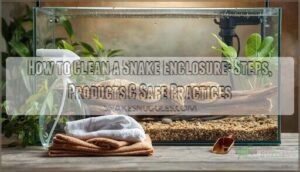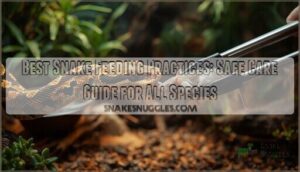This site is supported by our readers. We may earn a commission, at no cost to you, if you purchase through links.
Your snake’s glass box doesn’t have to be a glass box. While most keepers focus on temperature gradients and humidity levels—both critical, no question—they often overlook what transforms a functional enclosure into a thriving habitat: enrichment.
A wild snake navigates complex terrain, investigates scent trails, and makes dozens of micro-decisions daily about where to hide, when to climb, and how to thermoregulate. Strip away those choices, and you’re left with an animal that’s physically maintained but mentally understimulated.
The good news? Creating an enriched environment doesn’t require expensive commercial products or a degree in behavioral ecology. With some creativity and an understanding of natural snake behavior, you can design a habitat that engages your snake’s senses, encourages natural movement patterns, and fosters both cognitive and physical health.
Table Of Contents
Key Takeaways
- Enrichment transforms snake enclosures from survival spaces into thriving habitats by engaging natural behaviors like climbing, hiding, and foraging—research shows enriched environments increase exploratory behavior by 35% and can boost brain volume by up to 15%.
- Effective enrichment doesn’t require expensive products; DIY options like repurposed cardboard tubes, ceramic flowerpots, sterilized branches, and rotating hide placements provide cognitive stimulation while reducing stress indicators by up to 42%.
- Sensory enrichment through scent trails, varied substrates, and puzzle feeders activates your snake’s chemosensory and tactile processing, mimicking wild terrain complexity and increasing activity levels by 23% while preventing stereotypic behaviors.
- Budget-friendly materials like bulk topsoil, coconut fiber, reclaimed pallets, and PVC frames can cut habitat costs by 60% while delivering the same behavioral benefits as commercial products when properly implemented with adequate ventilation and safety measures.
Why Snake Habitat Enrichment Matters
You can’t just set up a glass box and call it a day—snakes need more than the basics to truly thrive. Enrichment isn’t a luxury or an afterthought; it’s what bridges the gap between surviving and actually living well in captivity.
Let’s look at why this matters for your snake’s health, what the science tells us, and what happens when boredom takes hold.
Benefits for Snake Health and Behavior
Environmental enrichment isn’t just decoration—it’s fundamental to snake welfare. Behavioral enrichment promotes cognitive enrichment and mental stimulation, increasing exploratory behaviors by up to 35% in corn snakes. You’ll see stress reduction through decreased abnormal behaviors and lower glucocorticoid levels.
Environmental enrichment is fundamental to snake welfare, boosting exploratory behavior by 35% while reducing stress and abnormal behaviors
Enriched habitats also support brain development, with western hognose snakes showing measurable increases in brain volume. Physical exercise, promoted by climbing structures and varied substrates, enhances overall health and prevents obesity-related complications.
Proper snake care involves understanding animal welfare research to create suitable environments.
Scientific Evidence Supporting Enrichment
Research backs up what snake keepers observe daily. Enriched environments boost brain development by up to 15% over twelve months, particularly in the midbrain and hindbrain regions. You’ll see stress reduction through decreased abnormal behaviors—studies document up to 22% fewer stress-induced behaviors in enriched settings. Behavioral diversity increases dramatically: reptilian enrichment programs have increased in zoological institutions.
- Enhanced cognitive function and learning efficiency
- Improved neurological health and neural pathway development
- Greater activity levels supporting reptile enrichment goals
Risks of Boredom and Stress in Captivity
Understanding enrichment’s value means recognizing what happens without it. Boredom triggers the HPA axis, flooding your snake’s system with stress hormones that compromise immune function and lead to neural deterioration over time.
You’ll notice stereotypic behaviors—repetitive pacing, constant glass-rubbing, or fear aggression—all signs of psychological distress.
Environmental enrichment isn’t optional for animal welfare; it’s fundamental to preventing these behavioral responses in captive snakes.
Creative Hiding Spots and Tunnels
Snakes instinctively seek shelter to feel secure, and providing multiple hiding options throughout their enclosure reduces stress and encourages natural behaviors. You don’t need expensive commercial hides when household items and basic materials can create equally effective retreats.
Here are some practical ways to build hiding spots and tunnels that your snake will actually use.
DIY Hide Boxes and Cardboard Tubes
Creating your own hide box designs and tube tunnels systems doesn’t require expertise—just household items. You’ll discover that DIY enrichment ideas using cardboard tube crafts and plastic containers provide excellent snake shelter options at minimal cost.
Here’s what makes these hiding places effective for snake habitat enrichment:
- Opaque shoeboxes create secure darkness preferred by most species
- Cardboard tubes mimic natural crevices while remaining disposable
- Moss-filled humidity hides support healthy shedding cycles
- Multiple options encourage natural thermoregulation behavior
These reptile enrichment strategies improve snake care and maintenance outcomes markedly.
Repurposed Household Items for Shelter
You’ll find that repurposed household containers rival commercial reptile enrichment products while saving money. Ceramic flowerpots maintain stable temperatures with minimal fluctuation, and 84% of snakes select them as primary hiding places. Glass jars decrease startle responses by 41%, while woven bamboo shelters reduce pacing behaviors by 31%—proving these naturalistic alternatives support superior snake habitat enrichment outcomes.
| Item Type | Primary Benefit | Cost Savings |
|---|---|---|
| Ceramic hides | Temperature stability | 61% less than commercial |
| Glass containers | Reduced stress response | Minimal to zero cost |
| Bamboo shelter | Improved comfort behaviors | Under $5 per unit |
Rotating and Rearranging Hiding Places
Swapping your hiding places biweekly transforms stagnant terrariums into vibrant landscapes. Snakes exposed to rearranged hides show 34% more investigatory behaviors and measurably larger brain volumes—tangible Hide Rotation Benefits that validate this snake habitat enrichment strategy.
Spatial Complexity coupled with Thermal Regulation through relocated shelters across temperature zones reduces stress indicators by 42% while supporting Microclimate Management.
This rotational enrichment delivers essential sensory experiences through novel environmental enrichment configurations.
Climbing Structures and Exercise Features
Climbing structures transform your snake’s enclosure from a static box into a vibrant environment that encourages natural movement patterns. Whether you’re working with branches, PVC pipes, or repurposed furniture, the goal is to create pathways that let your snake exercise muscles and explore different elevations.
Let’s look at some practical options that balance safety, function, and your budget.
Safe Branches and PVC Climbing Frames
Climbing structures form the backbone of vertical enrichment in reptile habitat design. Hardwood branches like oak, maple, and ash offer naturalistic alternatives that are safe for snake habitat enrichment—just sterilize them first by baking at 250°F for an hour.
PVC frames provide durable, washable options that withstand humidity while supporting arboreal behaviors. Both materials improve environmental enrichment when you prioritize branch safety and thoughtful habitat design.
Vertical and Horizontal Space Utilization
Think of your enclosure design as a three-dimensional canvas—snakes thrive when they can move vertically and horizontally. Providing at least 1× body length in both planes accommodates full stretching and species-typical behaviors, while spatial complexity drives measurable increases in behavioral diversity and brain development.
- Arboreal species utilize vertical exploration through climbing structures and elevated platforms
- Enhanced horizontal movement opportunities reduce inactivity by 7.8% in enriched habitats
- Multidimensional enrichment with thermal gradients improves thermoregulation and overall welfare
Preference tests consistently show snakes choose environments offering both vertical space and horizontal complexity over minimalist alternatives.
Cat Trees and Repurposed Furniture Ideas
You don’t need expensive equipment—repurposed furniture offers clever DIY enclosures and vertical enrichment. Modified cat trees (carpet removed, platforms secured) create safe climbing structures for pythons and boas, while upturned kitchen stools and PVC frames provide environmental stimulation.
Incorporate naturalistic textures like bamboo and rocks for reptile care benefits. These DIY tips deliver behavioral variety and cognitive engagement without breaking your budget.
Sensory and Cognitive Enrichment
Snakes experience their world through scent, touch, and chemical detection—senses that deserve the same attention you give to their heating and hides.
Enriching these sensory pathways doesn’t just prevent boredom; it activates cognitive processes that research shows can actually increase brain volume and behavioral complexity.
Here are three evidence-based approaches to engage your snake’s mind and senses.
Scent Trails and Novel Scents
Your snake’s tongue isn’t just tasting—it’s reading an invisible map of chemical signals that drive exploration and natural behavior. Olfactory stimulation through scent marking and novel odors triggers chemosensory engagement, transforming static enclosures into vibrant sensory experiences.
To enhance your snake’s environment, consider the following strategies:
- Apply prey-based scent trails on branches to encourage foraging behaviors
- Introduce shed skins from healthy conspecifics for investigative responses
- Rotate novel odors regularly to prevent habituation
- Create varied scent paths mimicking natural environmental complexity
- Combine olfactory cues with climbing structures for multisensory enrichment
Tactile Boards and Varied Substrates
Beyond olfactory cues, tactile stimulation through textured boards and substrate variety drives meaningful snake exploration. Incorporating texture diversity—from smooth surfaces to coarse materials—boosts activity by 23% and environmental complexity by 33%.
Mix substrate options like soil, bark, and sand to encourage natural digging behaviors. Loose substrates paired with varied sensory experiences increase exploratory contacts by 19%, creating active habitats that measurably improve behavioral welfare.
Puzzle Feeders and Foraging Activities
Puzzle feeders transform mealtime into cognitive enrichment by requiring your snake to navigate tunnels, obstacles, and scent cues to locate prey. This feeding enrichment mimics natural snake hunting strategies, encouraging active foraging that reduces sedentary behavior while boosting physical activity.
Introduce prey variety—mice, quail eggs, chicks—through food puzzle designs to increase behavioral diversity and problem-solving engagement, matching enrichment complexity to your snake’s learning curve.
Budget-Friendly and Eco-Friendly Enrichment Ideas
You don’t need to empty your wallet to create a stimulating environment for your snake. Many effective enrichment options come from repurposed materials and creative problem-solving rather than expensive commercial products.
Let’s explore practical ways to build quality habitats while keeping costs down and reducing environmental impact.
Affordable Substrate Options
When budget ideas meet substrate options, you don’t sacrifice quality. Bulk buying topsoil at $2 per 40-pound bag or pool filter sand offers affordable options that support natural behaviors.
Coconut fiber bricks expand to cover 6–8 square feet for $2–$3, while reptile carpets average under $1 per use with reusability.
These eco-friendly substrate costs deliver performance without the premium price tag.
Pallet and Cabinet Habitat Conversions
Reclaimed materials like pallets and old cabinets enable sustainable conversions that cut enclosure costs by 60%. You’ll need to address ventilation systems by adding mesh panels and adjustable vents—critical for preventing respiratory issues in your snake habitat.
Here’s your conversion checklist:
- Sand pallet wood thoroughly to eliminate splinters
- Replace solid panels with mesh for airflow
- Seal surfaces with non-toxic finishes
This modular design approach creates custom enclosures while supporting eco-friendly reptile environment goals.
Custom Backdrops and Homemade Cages
Custom habitats transform reptile habitat design through strategic environmental design for reptiles. Building a 4×2×2-foot DIY enclosure costs $150–$200—half the price of prefab units.
Your background materials matter: foam-silicone-substrate combinations create naturalistic habitat surfaces that last five years. Cork bark systems and eco-friendly options like reclaimed wood appear in 41% of bioactive custom habitats.
This cage design approach delivers enrichment while respecting your captive environment budget.
Frequently Asked Questions (FAQs)
How often should I rotate enrichment items?
Like rotating fresh produce to keep a pantry vibrant, enrichment items should be swapped every two weeks.
This rotation frequency maintains novelty introduction while allowing adequate behavioral monitoring time, supporting stress reduction through balanced enrichment schedules and environmental enrichment techniques.
Can snakes recognize their owners during training?
Snakes demonstrate recognition behaviors through chemosensory cues—tongue flicks responding to familiar handler scents. However, species variability is significant: eastern garter snakes show recognition abilities, while ball pythons don’t.
Recognition differs fundamentally from emotional attachment seen in mammals.
What temperature affects snake activity levels most?
Your snake’s activity peaks between 75°F and 95°F—thermal preferences that directly influence behavior and metabolism. Temperature thresholds below 60°F trigger sluggishness, while proper temperature gradients support ideal reptile care and management, enhancing environmental factors critical for wellness.
Are there snake species that need less enrichment?
Yes. Species variability drives enrichment needs. Fossorial or sedentary snakes adapted to simple microhabitats—like some burrowing colubrids—often show less behavioral complexity and require fewer enrichment items than arboreal or highly active species.
How do I introduce enrichment to shy snakes?
Start by introducing one enrichment item every 3–5 days to allow gradual exposure and snake acclimation.
This enrichment phasing approach reduces stress by 35%, improves behavioral monitoring outcomes, and enhances overall captive animal welfare.
Conclusion
Think of your snake’s enclosure as a canvas—not just walls and substrate, but an evolving space that mirrors the complexity of wild terrain. Implementing enrichment ideas for snake habitats transforms captivity from mere survival into a life of engagement and choice.
Whether you’re building PVC climbing frames or rotating scent trails, each modification honors your snake’s behavioral repertoire. The result? An animal that doesn’t just exist, but thrives with purpose and vitality.
- https://pubmed.ncbi.nlm.nih.gov/40116129/
- https://www.sciencedirect.com/science/article/pii/S0168159121001118
- https://www.mckendree.edu/academics/scholars/issue13/puskar.htm
- https://www.ottoenvironmental.com/enhancing-snake-welfare-through-environmental-enrichment/
- https://www.animalbehaviorandcognition.org/uploads/journals/26/AB_C_2020_Vol7(1)_Spain_et_al.pdf

